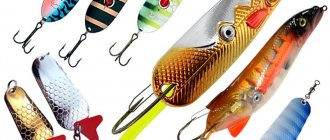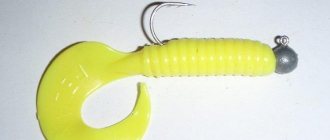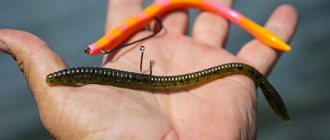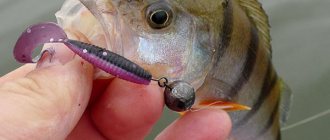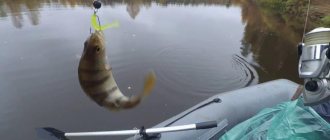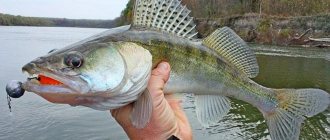Pike fishing leaves no one indifferent to either the novice or the experienced angler. The excitement inherent in catching a predator often captures us entirely and keeps us in suspense until the moment when the head or fin of a fish appears on the surface and a landing net is placed under it. The problem with a successful bite is that pike do not like open places. She hides in ambush - in thick coastal grass or submerged snags. In such places there is a high risk of catching classic baits: spinners with a tee or wobblers. Fishing with unloaded tires comes to the rescue.
Tackle
Tackle for fishing with unloaded rubber is an imitation of fish, crustaceans or worms/amphibians made of silicone rubber. In terms of variety of shapes, colors and sizes, silicone baits are superior to all other types of devices for catching predators. This allows you to experiment in a wide range, selecting the most suitable bait depending on the density of aquatic plants in the fishing areas, water temperature, which affects the activity of the predator, the visibility of the bait against the background of the bottom surface and aquatic vegetation.
In addition to the silicone bait itself, equipment for pike fishing includes:
- Hook (usually offset - with a latch that protects the hook tip from catching on an obstacle);
- A leader made of steel, titanium or fluorocarbon;
- Fishing line or nylon cord;
- Rod/spinning rod;
- Inertia-free reel 3000-4000 or multiplier.
Unloaded tires in cold water
Fishing with silicone baits is becoming increasingly popular among anglers every year. The reason lies in the huge variety of these baits and their high catchability. There are various mounts with rubber, which allows you to choose the optimal equipment for certain fishing conditions... Almost every spinning angler has fished with soft baits at least once. Some people find this kind of fishing addictive, while others find it more interesting to fish with wobblers and iron. But nevertheless, rubber has become one of the main types of bait for the modern spinning fisherman. Fans of jig fishing equip lead weights with large vibrating tails and twisters (up to 5–12 cm), adherents of microjig catch predatory fish with creatures up to 5 cm in size. A variety of silicone is also used for other bottom rigs. Soft baits can be classified as a separate category of spinning tackle. Rubber can vary in several ways, and their combinations can be optimal for catching specific fish in certain conditions:
— shape (crustaceans, slugs, worms, twisters, vibrotails, shad);
- color;
- size (large, small, medium);
- type (floating, sinking);
- smell;
- consistency (hardness).
By combining the characteristics of soft baits such as shape, size and type, you can target a variety of fish. Small sizes are suitable for perch; for bass and pike perch you need to use larger silicone. The largest baits (4-6 inches) are for pike. When selecting the size of baits, you should always focus on the typical size of food objects in a particular body of water.
Having chosen the type and size of bait, you can begin to select special parameters: smell (taste) and hardness. There are sweet, spicy, fishy and other smells, and of varying concentrations. When fishing for active fish, I would classify the rigidity of silicone as a secondary parameter. But as soon as the bite stops, and the bites become sporadic and sluggish, even such a characteristic as the hardness (softness) of baits begins to become important.
When catching a specific fish, I choose the bait I need in this order: 1) size, type, shape; 2) color; 3) smell and taste. Each stage of selecting the optimal soft bait will be influenced by the degree of passivity of the fish and its preferences, which are revealed directly during fishing. In some cases, the sequence of selecting rubber characteristics may change. For example, when fishing for passive pike in muddy water at shallow depths, color becomes of paramount importance, and only then the smell and size of the silicone. Color and smell in this case will be the main irritants of the predator.
For several seasons in a row I have been mastering fishing with unloaded silicone. The more you get, the more interesting it becomes, you want to experiment and understand further. The main thing is an adaptive approach, allowing the use of unloaded equipment and appropriate baits only in those conditions where it is justified.
Previously, I tried to use unloaded soft baits in deep places, in the grass, on open shallows, stones, that is, everywhere. The result was negative. But as soon as I used trial and error to formulate for myself the optimal conditions for effective fishing for such an installation, the result immediately appeared. So, in my opinion, the most interesting places to use such a montage are:
1) areas of the reservoir densely overgrown with underwater vegetation; in such places, silicone moves not only between the grass stems, but also through the vegetation itself;
2) shallow areas with an overgrown bottom; in such places the gap between the water surface and the underwater grass is 15–40 cm;
3) snags and other “strong” places; in such conditions, the wobbler will cling to obstacles, and the loaded rubber will get tangled in branches and play in a vertical plane, hanging from snags.
There are quite a lot of places that fall under the described conditions. These are floodplain sections of rivers with a depth of up to 1–2 m and an overgrown bottom, as well as medium rivers with many snags and rubble. In my opinion, the Astrakhan peals stand apart, where the huge water area is filled with underwater grass and shallow depths.
It is on the ridges that unloaded rubber becomes one of the main effective equipment - both in the reed bushes and on the ridges themselves, where plants creep along the bottom. Other baits, for example, hard ones (wobblers, spinners, spinners) will catch the grass, and the retrieve will be ineffective.
On medium rivers in densely overgrown grassy areas, as well as in dense snags at a depth of 1–2 m, unloaded rubber will become one of the most effective equipment. In this case, large rubber can be loaded with jig heads weighing up to 2 g. Using a minimum load will give balance to the entire installation, and will also allow you to more accurately control the movements of large soft baits at shallow depths.
This is necessary in snags, when you need to lower the bait to a certain depth and play with it almost in one place. You can hold the rig in one place with minimal load if the cord hangs vertically down from a snag or branch. In this case, you can use the rod to move the rubber vertically and return it to its original position. Perch likes this kind of game not only on medium-sized rivers, but also on forest streams with numerous impassable blockages.
According to my observations, the most suitable time for fishing with unloaded silicone is the cold season, best from September to November. Predatory fish (perch and pike) noticeably increase in activity after summer. Finding fish is not difficult compared to the winter period, it is easier than in the summer, since there is less grass after the hot months, but it still does not disappear before winter. It is in the grass that a predator hides in anticipation of its prey. In addition, until the water level drops in winter, proven snags remain under water, in which, for example, pike are consistently present.
Fishing with unloaded rubber can also be effective in the spring, before the start of the spawning ban, especially on forest rivers and streams. Pike rises up the reservoir against the current to spawning grounds: to floodplain areas and water meadows. It is in such areas with shallow depths and dense underwater vegetation that it is worth using soft baits that will pass through the grass without snagging. Spring pike are demanding and selective, so you have to experiment with silicone and wires.
It is difficult to say who loves unloaded rubber more - pike or perch. Where the toothy one predominates, it becomes the main object of fishing. But, as a rule, the most common trophy when fishing with such equipment is perch, of medium and large size.
In the dark, you can also catch pike perch when it comes close to the shore. The fish rises from the holes into shallow water behind a school of bleaks. If you don’t make any noise, the fanged one can attack artificial baits almost at your very feet. This kind of fishing is tied to areas of the reservoir where the holes open up to a rocky or sandy coastal shoal. If there are artificial drains and streams at such points, the chances of biting pike perch at night increase. In addition, the accumulation of a large number of fry in one area, as a rule, indicates that there is a predatory fish lurking nearby that migrates behind large schools of peaceful fish.
On medium rivers, such as the Medveditsa in the Saratov region, on one of the autumn rafting trips one member of the team managed to successfully catch pike in the grass using lightly loaded rubber. When we passed densely wooded sections of rivers with depths of up to 1.5 m, we stopped and drifted. While we were carried along by the current, we methodically fished for grass near the shore and in the fairway, as well as snags. I used wobblers, and nothing worked for me, since the wiring was interrupted by snags or the bait returned to me with a tuft of grass.
Another rafting participant had a lightly loaded rig with 1.5–2.5 g of lead, coupled with a large brightly colored Gary Yamamoto 4' Single Tail Grub (chartreuse/silver flk.). In this case, the load was needed precisely to balance the center of gravity of the large twister and more accurate play. Under the minimum weight of lead, when falling, the bait tilted down, and the action of the tail was active. Pike responded to such equipment willingly and regularly. If, under those conditions, the twister had not been loaded with such a pellet, it would have sank evenly with barely noticeable vibrations of the tail. In my opinion, the result was influenced by the color and size of the silicone and the type of equipment, which made it possible to fish different water horizons with a hook hidden in the body.
For different fishing conditions (reservoir, fishing object, time of year and day), it is worth selecting a specific silicone. Of the many suitable options, as my experience suggests, it is better to have different types of bait with you when fishing, by type, shape, color and size. This will allow you to quickly select the optimal tires. I have recently developed a working set of specific soft baits.
Fox Rage Warrior Tiddler Fast 4.7″
(photo 1) - vibrotail. The body of the bait repeats the appearance of a small peaceful fish, for example, bleak. The tail part noticeably tapers towards the fin, which allows for more active play on the retrieve. This lure has good flexibility, but its size when mounted unloaded is best suited for pike fishing. It is a bit large for a perch. Even in the Astrakhan epicenters of perch biting, there were no catches with this rubber, but only timid idle bites.
Nories Spoon Tail Shad 4″
(see photo 2) - another vibrotail. It differs from Tiddler Fast not only in size, but also in shape and game. I would list the following features of this bait:
- positive buoyancy. This allows the bait to sink with its head down and rise to a vertical position upon contact with the bottom or grass. By changing the type and size of hooks, you can achieve balancing of the entire installation so that the entire equipment is floating, which will allow you to fish on the very surface of the water. This is true in heavily overgrown places, where underwater grass spreads along the surface of the water;
- tail geometry. The fin is wide and concave, the tapering tail part is made of dense rubber - this shifts the emphasis in the game from the tail part of the bait’s body to the tail itself. The fin starts up immediately on the retrieve, its vibrations are high-frequency, which appeals to both active and passive perch;
- body details. First of all, these are visually prominent large eyes, and secondly, filling the belly of the bait with glitter for a believable imitation of a fry.
The practice of fishing with unloaded rubber has shown that this is the best bait for active perch in areas of the reservoir that are heavily overgrown with grass. The size of the rubber cuts off obvious small things, and bright colors become a real irritant for striped robbers.
Ecogear Rock Claw 3″
(photo 3) is a clear imitation of a crustacean. This bait has large “claws”, long thin antennae and a dense body. On an unloaded rig, it is the claws and antennae that have a provoking effect on the fish. During smooth jerks, the claws extend widely and stop, and the antennae continue to oscillate. As soon as pike and perch bite off the antennae, the number of bites immediately decreases. Therefore, in such cases, you should immediately put on a new bait.
Rock Claw, due to its small size and light weight, sinks more slowly than the larger Tiddler Fast and Bug Ants. For this “crustacean” I use smooth jerks that actively move the bait’s limbs. Of all the baits under consideration, this is the smallest. Its size attracts not only medium and large perch, but also small perch.
Ecogear Bug Ants 4″
(photo 4) is also “crustacean” in shape, but larger than Rock Claw. The body of the bait consists of four pairs of short legs, two large blades and long thin antennae. The structure of the body is similar to the silicone discussed above. The game is similar if you perform wiring in the water column. But the wiring of these baits is different - Bug Ants have a more massive creature, which sinks faster, therefore, in order to unlock the potential of the bait, it is necessary to make more frequent jerks with the rod, preventing the rubber from going too deep.
The colors of this soft bait are interesting: one color on the bottom of the body, another on the top. I like it when these colors contrast. When fishing occurs in the grass itself, passing through the stems of underwater plants, the “crustacean” turns, now one side, then the other. It seems to me that the change of colors during the fishing is an additional irritant for predators such as perch and pike.
Mann's Lucky 9 cm
(photo 5) - a classic twister. The massive body allows you to cut off small things when fishing, and the dense tail helps you use this rubber longer even with active biting. Bright color and strong vibrations when playing are good at luring perch out of dense grass.
My friend actively fished with this bait in the Astrakhan rumbles. In areas heavily overgrown with grass, where active perch were hiding, this twister regularly provoked a bite from the largest perch within the fishing radius.
Ecogear Inkajaco 3–1/2
(photo 6) has a double tail. The body of the bait is ribbed, soft and flexible. Despite its length, this rubber is one of the lightest among those reviewed, so throwing it the desired distance is problematic. It is best to fish with it from a boat when there are areas of perch concentration nearby or when the wind is blowing at your back.
Inkajaco is more to the taste of perch than pike if you use this soft bait on an unloaded rig. Moreover, both pelagic fishing and fishing from the bottom at shallow depths show good results. Inkajaco has an active game of its own, so both even and jerky retrieves will be effective.
I would divide the wiring for all baits into several main ones:
- swaying. In this case, it is necessary to set the play of the passive bait with the tip of the rod so that the movements of the silicone in the water are similar to real living organisms;
- uniform. This type of animation is suitable for rubber with active play. As a rule, these are twisters and vibrotails;
- jerky. This type of wiring allows you to fish the surface water zone, as the soft bait is thrown in different directions in the horizontal plane;
- spasmodic. The movements of the bait occur in a vertical plane - the silicone either sinks, then accelerates up and falls again.
Types of fishing often have to be combined, especially when fishing for passive perch and pike. Moreover, even when the fish is active, it can react differently to one or another method of wiring. For example, if the depth in the fishing area is shallow and the pike stays near the bottom, jumping retrieve is suitable. If the perch actively hunts for fry between the carpet of underwater grass and the surface of the water, the best retrieve will be jerking.
At the same time, by influencing the speed of the retrieve and the duration of pauses, you can successfully select the key to catching predatory fish. Ingenuity in animation style contributes to successful fishing with unloaded rubber on various bodies of water. There are bodies of water with a high concentration and activity of striped robbers and toothy ones. In such places, the bite is stable when using different types of wiring. But there are bodies of water, for example, the Moscow River in its middle course, where, in order to achieve results, you cannot do without improvising with the installation of unloaded rubber.
When fishing with unloaded rubber, well-chosen spinning tackle is of great importance. The casting equipment is light in weight, and the large size of the rubber sails during flight. These circumstances hinder the casting distance, so you should select a long rod of moderate action, light (L) or medium-light (ML) power with a “live” tip. , the Talon VI PLUS 8'3″-MLXF2 became such a spinning rod
(photo 7).
The reel also has special requirements: given the light weight of the bait used, it must lay the thin cord evenly and not drop the loops. The Shimano Twin Power 11 2000S reel is best suited for these purposes. We also place high demands on the cord: it must be round, slippery and reliable. Fishing with an unloaded rig, as a rule, takes place in not the most favorable conditions (grass, branches, snags), so the “thread” should not be thin. But it is important not to overdo it with thickness, otherwise the casting distance will be reduced. One of the main working cords for me was Yamatoyo Famell PE SW Super #0.8.
Another important component of unloaded equipment is hooks. They perform not only their main function (to detect fish), but also have a direct impact on the weight of the installation. You can select hooks of different shapes, sizes and thicknesses to suit the dimensions of the soft bait used, affecting the weight and balance (center of gravity) of the silicone. Hooks together with metal leads (when fishing for toothy ones) provide sufficient weight so that the rig can be cast to the required distance.
Hooks must be sharp and secure. These parameters will allow you to spot and fish out even large pike. In addition, when fishing in grass and snags, sometimes it is necessary to pull the fish directly from underwater obstacles. In such cases, it is important that the hook does not bend. That is why high demands should be placed on the quality of hooks. Various manufacturers make good hooks (photo 8). Because of the variety of patterns and reliability, I use Vanfook hooks, such as Worm 55B Flat NS Black #1/0.
When fishing with unloaded rubber, the casting distance can be increased, several times, if you cast into the wind: the stronger the wind, the further the equipment flies. There is one caveat: it is not easy to catch a tailwind on medium-sized rivers with forested banks, as well as in urban environments, where there are buildings along the banks. The situation is different when fishing from a boat - you can turn around and cast into the wind, and also swim to a promising point from any direction.
A slight load (lead, hook) affects the movement of the bait. In some conditions, a change in weight is required to improve the balancing of the entire installation and obtain the result. If, for example, you use an overloaded soft bait in shallow water with a depth of up to 50 cm, the rubber will sink passively and effective retrieval will not work.
Epilogue
Summarizing all of the above, I would like to emphasize that unloaded rubber is not effective in catching predatory fish in all bodies of water.
It is not advisable to use this installation in a strong current, since with a short casting distance the flow will not allow the soft bait to be carried out properly. The game will go astray, and the trajectory of the wire and the movement of the rubber itself will not allow you to purposefully fish promising places. But there is a rule: the faster the current, the heavier the installation should be (hook, leash, pellet). In small and medium currents, so that the action of the bait is not disturbed by the flow, and manipulations with the rod give clear movement to the rig, you need to make the equipment heavier (shotgun, hook, leash). This is true on medium and small rivers, where pike stand in dense grass not only near the shore, but also on the riverbed.
The use of unloaded equipment is justified in reservoirs without current and in sections of rivers where the current is slow or absent. Particular attention should be paid to the depth of the fished area of the reservoir. Working depths for unloaded fishing, it seems to me, are up to 2–3 m. In deeper areas, it is more advisable to use weighted equipment with silicone or other baits (wobblers, spoons).
The material was published in the April 2014 issue of the magazine “Fishing in Rus'”
Lures
Unloaded silicone bait for pike fishing is a dummy of an aquatic animal, used without additional loading with lead weights included in the equipment. The advantages of such a bait are felt when fishing in heavily overgrown or snag waters, where there is a high risk of snagging and losing expensive spinners or wobblers.
To make fishing comfortable and have the opportunity to fully use the potential of the rod and spinning reel, special attention is paid to the selection of bait. The specificity of fishing with unloaded rubber is that the fisherman is not able to make long casts due to the low weight of the rubber. To partially compensate for this inconvenience, they try to use medium-sized baits measuring 90-100 mm and weighing at least 5-6 grams. Combined with the weight of the leash and offset hook, the total weight of the equipment is close to 7-9 grams, which allows you to cast at 20-25 meters when fishing from the shore. This is quite enough to cross the border of coastal vegetation and lead the line towards the thickets of aquatic plants in which the pike usually hides.
About
How to fish correctly
Fishing with silicone requires a special way. The reason is that if there is no load, then during a pause the bait begins to either sink or freeze, like a suspended wobbler. In this case, non-loading can be carried out in various ways. This includes an even game, twitching, and stops combined with sudden movements. Experienced people say that the last two methods work best, because they encourage the fish to start biting.
It is worth noting that the color of the bait should be noticeable. It is better to give preference to light green, green, orange or red.
If weak bites are noticeable, there is no need to take any action, you need to wait a little and give the fish the opportunity to see what is being offered to it. Usually after “empty” bites the really effective ones begin.
Lunker City Swimfish 3.75” and 5 , as well as Bass Assassin Turbo Shad 4, as silicone baits for unloaded fishing . Regardless of the type of fishing, they will come in handy because they are made of high-quality silicone, which guarantees safety in the event of snags and false bites. In addition, they have a “heel” that ensures excellent play.
If you decide to fish with swimfish, then it is advisable to put it on the offset rig sideways to reduce the number of “empty” bites. At the same time, the visibility of the element will improve.
Beginner fishermen can start trying to fish with an unloaded rubber band on a small river in order to somehow get a little used to such bait. Over time, you can even move to a body of water with a current. If you don't rush, everything will go well.
Fishing technique, wiring
The fishing technique consists of casting the bait and holding it for a long time before the start of the retrieve. At this time, the rubber bait slowly sinks to the bottom or onto aquatic plants, making oscillatory movements characteristic of a wounded fish. After the bait sinks to the bottom, they begin to reel in the fishing line. Make 3-5 sharp turns of the coil and after them a pause of 5-10 seconds. During movement, the bait actively vibrates with its tail, creating vibrations in the water column, and its slow descent to the bottom provokes the predator to attack.
Choosing the size and shape of a vibrating tail for pike fishing
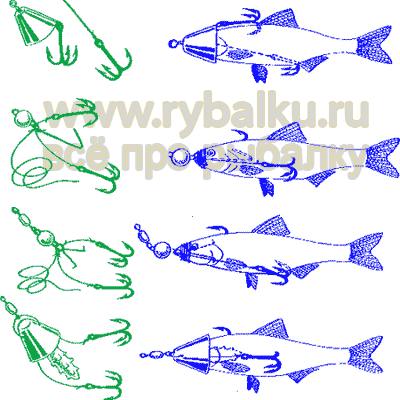
As for size, pike are not particularly picky about what they eat, except on hot summer days. At this time, she rarely chases prey, but is content to swim by itself. This behavior is also typical for the pre-spawning period. For such periods, it is better to use rippers no longer than 50 mm as bait.
The vibrotail for pike in the fall and spring after spawning should have a length of 70 mm. The optimal size of silicone for the time of greatest activity of this predator is considered to be 70-120 mm.
And here's what you need to know: Penalty for catching sterlet
Video
Preference for fishing with unloaded silicone is given in the summer and early autumn, when the surface of the reservoir is heavily overgrown and the use of other types of bait leads to an inevitable snag. The loss of a cheap silicone bait is not comparable to the loss of an expensive wobbler; moreover, it allows you to fish areas that are most promising from the point of view of finding pike in them - dense coastal thickets.
Views: 187
Similar articles:
- Catching pike with silicone. The best silicone lures for pike Silicone lures for pike are baits that are consistently popular...
- Equipment for silicone baits. How to attach silicone bait to a hook. Silicone baits are artificial baits for catching fish that...
- Jig-rig: installation, wiring methods, advantages and disadvantages Just 3-4 years ago, when jig-rig was just gaining popularity, many…
- Carolina equipment for spinning: installation, fishing technique, wiring Until recently, components and equipment for fishing did not allow…
The best vibrating tails for pike
Vibrating tails have recently been gaining popularity literally every day. This is achieved thanks to the simple control method, good price and large catch. In the distant past, they have forced wobblers and no less popular twisters out of the market. Which ones have the best characteristics?
If you plan to use a vibrating tail for pike as bait, check out the most successful models. Despite the fact that the fishing tackle market is literally overflowing with products from various manufacturers, Relax and Mann`s are considered the most successful models of vibrotails. Don't miss the vibrating tails from Yum, Lucky John, Cormoran, Bass Assassin.
Be sure to keep in mind that the vibrotail is an active type of bait; these are not standard “worms”, “lizards” or “octopuses” made of silicone. Remember this when choosing lures, because most well-known manufacturers specialize in only one area of lure manufacturing.
In terms of its characteristics, the vibrotail came out on top not only among silicone and foam spinners, but also among others.

How to cast with a spinning rod correctly? You will find the answer to this question in our article. And here you will read about oscillating spoons. On our website https://lovisam.net/ there are many more informative articles for those who like to fish.
There are a large number of models on display in store windows, varying in size, shape and price. Some choose vibrating tails from well-known and popular brands, others prefer to buy budget baits.
Both among the former and among the latter, there are vibrotails that perform better than others on the pond and have earned an excellent reputation among spinners, as they bring excellent catches.
Mann's Flipper
A catchable bait made of soft silicone, which is available in a large number of colors and is affordable. Mann's Flipper is well suited for twitching pike fishing.
Mann's Predator
Pros and cons of edible rubber
When pike activity is poor, spinners use baits from the “edible rubber” class. They are especially in demand in cold weather, when the number of bites decreases and the fish refuses to respond to products with active play.
Edible rubber has both advantages and disadvantages. The main advantage is the possibility of use in difficult conditions, including: dense thickets of vegetation, snags and rocky bottom.
The products have a well-thought-out shape, so they demonstrate active and realistic play with any wiring. They also have an intense aroma that attracts toothy predators from a great distance.
The main disadvantages of rubber include a limited service life and increased elasticity, due to which the bait is easy to deform.
Rubber fish are especially effective in shallow water areas where grass pike are found. It responds perfectly to any variations of edible rubber that are within its visibility range. The main thing is to choose the appropriate equipment and beautifully present the artificial prey to the fish.

